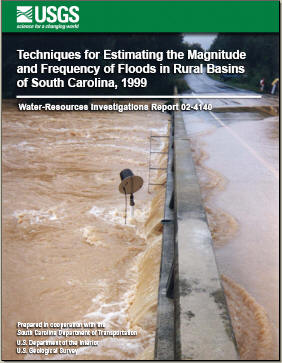Water-Resources Investigation Report 02-4140
U.S. Geological Survey Water-Resources Investigation Report 02-4140, 34 pages (Published 2002)
By Toby D. Feaster and Gary D. Tasker
![]() This report is available online in pdf format (3 MB): USGS WRIR 02-4140
This report is available online in pdf format (3 MB): USGS WRIR 02-4140
Errata sheet || Appendix A • Appendix B • Appendix C • Appendix D

Data from 167 streamflow-gaging stations in or near South Carolina with 10 or more years of record through September 30, 1999, were used to develop two methods for estimating the magnitude and frequency of floods in South Carolina for rural ungaged basins that are not significantly affected by regulation. Floodfrequency estimates for 54 gaged sites in South Carolina were computed by fitting the water-year peak flows for each site to a log-Pearson Type III distribution. As part of the computation of flood-frequency estimates for gaged sites, new values for generalized skew coefficients were developed. Flood-frequency analyses also were made for gaging stations that drain basins from more than one physiographic province. The U.S. Geological Survey, in cooperation with the South Carolina Department of Transportation, updated these data from previous flood-frequency reports to aid officials who are active in floodplain management as well as those who design bridges, culverts, and levees, or other structures near streams where flooding is likely to occur.
Regional regression analysis, using generalized least squares regression, was used to develop a set of predictive equations that can be used to estimate the 2-, 5-, 10-, 25-, 50-, 100-, 200-, and 500-year recurrence- interval flows for rural ungaged basins in the Blue Ridge, Piedmont, upper Coastal Plain, and lower Coastal Plain physiographic provinces of South Carolina. The predictive equations are all functions of drainage area. Average errors of prediction for these regression equations ranged from -16 to 19 percent for the 2-year recurrence-interval flow in the upper Coastal Plain to -34 to 52 percent for the 500-year recurrenceinterval flow in the lower Coastal Plain.
A region-of-influence method also was developed that interactively estimates recurrence- interval flows for rural ungaged basins in the Blue Ridge of South Carolina. The region-of-influence method uses regression techniques to develop a unique relation between flow and basin characteristics for an individual watershed. This, then, can be used to estimate flows at ungaged sites. Because the computations required for this method are somewhat complex, a computer application was developed that performs the computations and compares the predictive errors for this method. The computer application includes the option of using the region-of-influence method, or the generalized least squares regression equations from this report to compute estimated flows and errors of prediction specific to each ungaged site. From a comparison of predictive errors using the region-of-influence method with those computed using the regional regression method, the region-of-influence method performed systematically better only in the Blue Ridge and is, therefore, not recommended for use in the other physiographic provinces.
Peak-flow data for the South Carolina stations used in the regionalization study are provided in appendix A, which contains gaging station information, log- Pearson Type III statistics, information on stage-flow relations, and water-year peak stages and flows. For informational purposes, water-year peak-flow data for stations on regulated streams in South Carolina also are provided in appendix D. Other information pertaining to the regulated streams is provided in the text of the report.
Abstract
Introduction
Purpose and Scope
Previous Investigations
Description of Study Area
Acknowledgments
Peak-Flow Data
Quality Assurance/Quality Control
Estimation of Flood Magnitude and Frequency at Gaging Stations
Flood Frequency
Skew Coefficient
Synthesized Peak Flow
Estimation of Flood Magnitude and Frequency at Ungaged Sites
Ordinary Least-Squares Analysis
Generalized Least-Squares Analysis
Accuracy of the Method
Region-of-Influence Method
Comparison of Methods
Limitations
Computer Software
Application of Methods
Flood Frequency at Gaged Sites for Streams Draining One Physiographic Province
Flood Frequency Near Gaged Sites on the Same Stream Draining One Physiographic Province
Flood Frequency at Ungaged Sites on Streams Draining More Than One Physiographic Province
Flood Frequency at Gaged Sites on Streams Draining More Than One Physiographic Province
Broad River
Little Pee Dee River
Lynches River
Edisto River
Salkehatchie River
Flood Frequency at Gaged Sites on Regulated Streams
Pee Dee River
Catawba River
Wateree River
Saluda River
Congaree River
Santee River
Savannah River
Pacolet River
Summary
Selected References
![]() This report is available online in pdf format (3 MB): USGS WRIR 02-4140
This report is available online in pdf format (3 MB): USGS WRIR 02-4140
To view the PDF document, you need the Adobe Acrobat® Reader installed on your computer. (A free copy of the Acrobat® Reader may be downloaded from Adobe Systems Incorporated.)
For more information, contact the South Carolina Publications Unit.
![]() USGS South Carolina Publications • South Carolina Water Science Center
USGS South Carolina Publications • South Carolina Water Science Center